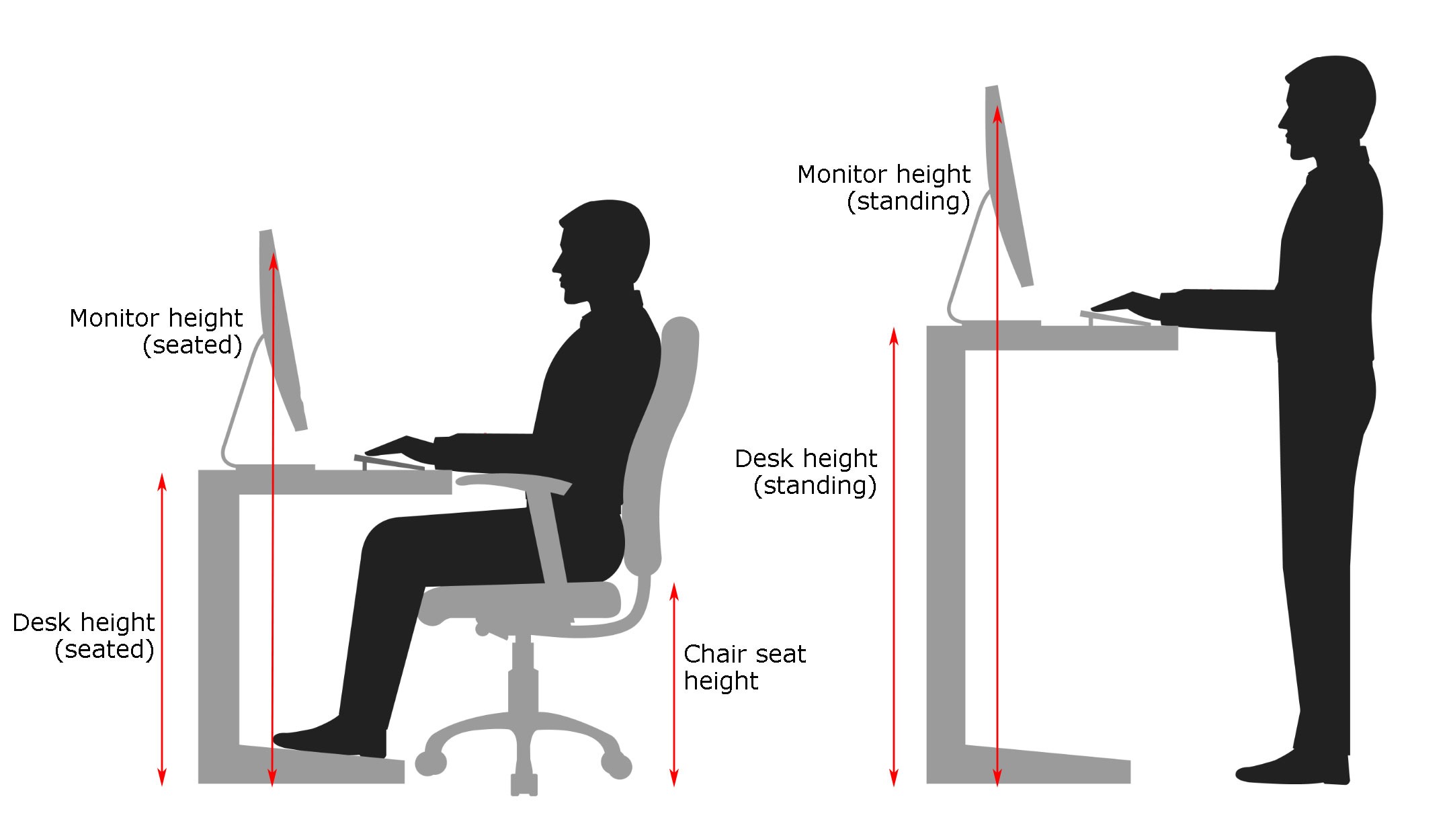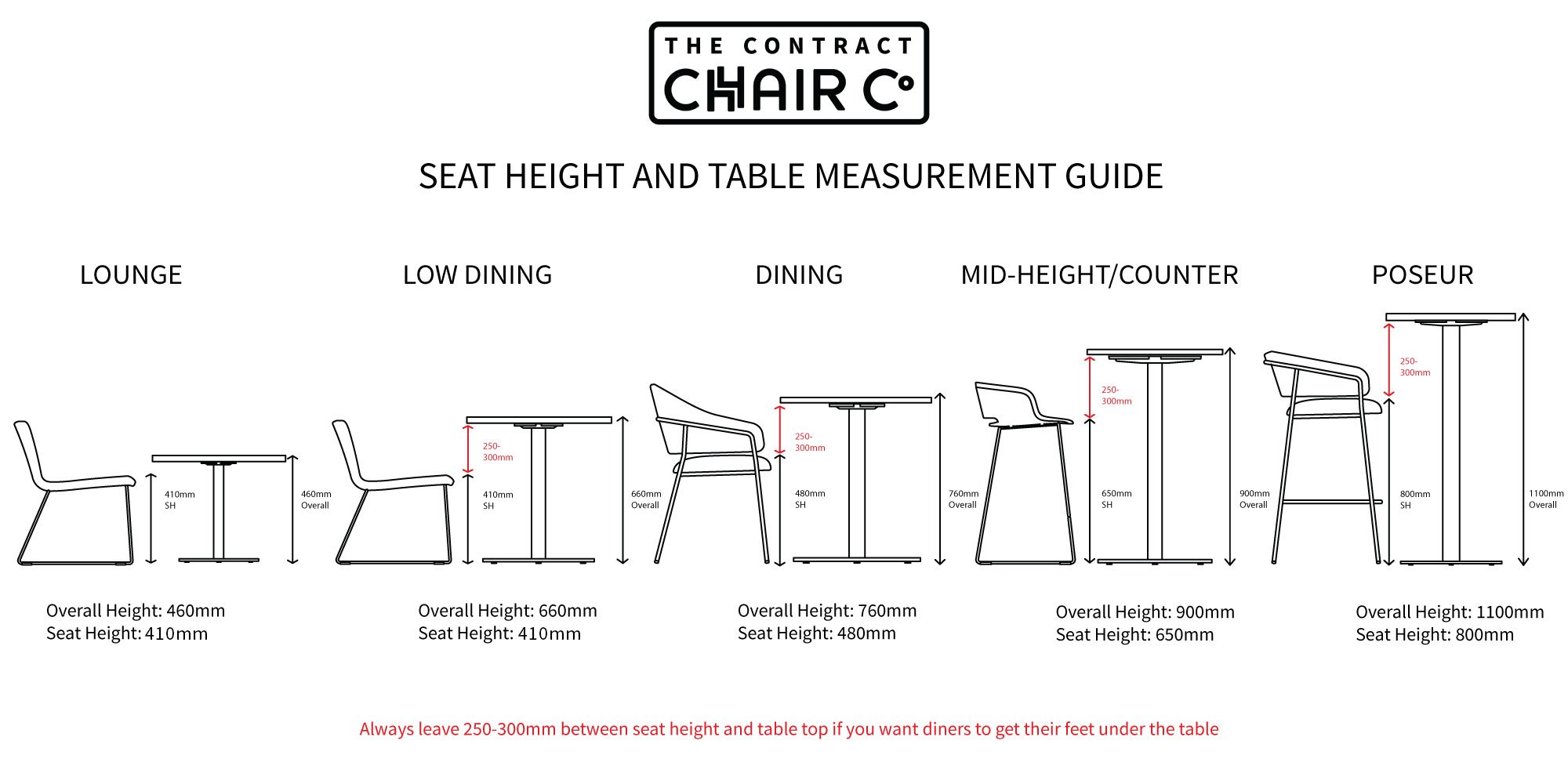Ergonomics and Standard Desk Chair Height

Maintaining the correct desk chair height is crucial for optimal posture and overall well-being. A chair that’s too high or too low forces your body into unnatural positions, leading to discomfort and potential long-term health problems. Finding the sweet spot ensures your body is supported correctly, promoting comfort and preventing strain.
The Relationship Between Chair Height and Posture, Standard desk chair height
Proper posture involves aligning your body’s natural curves, reducing strain on your muscles and joints. When your chair is the correct height, your feet should rest flat on the floor, your thighs should be parallel to the ground, and your back should comfortably rest against the chair’s backrest. This alignment distributes your weight evenly, minimizing pressure points and preventing fatigue. Conversely, an incorrectly adjusted chair forces your body into awkward positions, potentially leading to slouching, hunching, or other postural deviations that strain your spine, neck, and shoulders.
Negative Health Consequences of Incorrect Chair Height
Using a chair of the wrong height can lead to a cascade of negative health consequences. A chair that’s too high forces you to hunch over, straining your neck and shoulders, potentially leading to chronic neck pain, headaches, and even carpal tunnel syndrome. Sitting too low, on the other hand, can cause your thighs to be unsupported, leading to pressure on the backs of your legs and potentially poor circulation. This can also cause strain on your lower back and hips, leading to lower back pain, sciatica, and other musculoskeletal issues. Prolonged periods of sitting in an incorrectly adjusted chair can also contribute to poor posture, increasing the risk of long-term back problems and potentially affecting your overall physical health.
Adjustable Chair Features for Personalized Height Adjustments
Many modern office chairs offer adjustable features to accommodate individual needs and preferences. The most common is a height adjustment lever, typically located under the seat. This lever allows you to easily raise or lower the seat to find the perfect height. Some chairs also feature adjustable lumbar support, allowing you to customize the curve of the backrest to better support your lower back. Pneumatic lift mechanisms are frequently used, providing smooth and effortless height adjustments. Furthermore, some high-end chairs include features like adjustable armrests, allowing you to position your arms comfortably, and tilt mechanisms, which allow you to recline for added comfort and postural variation.
Effects of Different Chair Heights on the Body
The following table summarizes the effects of sitting at various chair heights on different body parts. Note that these are general observations and individual experiences may vary.
| Body Part | Too High | Too Low | Ideal Height |
|---|---|---|---|
| Neck | Strain, pain, headaches | Minimal impact | Neutral posture, minimal strain |
| Shoulders | Hunching, rounding, pain | Minimal impact | Relaxed, supported |
| Back (Lower) | Minimal impact (if good posture is maintained), otherwise slouching | Strain, pain, discomfort | Supported, neutral curve |
| Hips | Minimal impact | Pressure, discomfort | Supported, neutral angle |
| Thighs | Minimal impact | Pressure, poor circulation | Parallel to the floor |
| Feet | Dangling, discomfort | Flat on the floor (potentially cramped) | Flat on the floor |
Measuring and Adjusting Desk Chair Height

Finding the perfect desk chair height is crucial for comfort and preventing long-term musculoskeletal issues. It’s a surprisingly simple process, but getting it right can make a world of difference to your workday. This section will guide you through accurately measuring and adjusting your chair for optimal ergonomic support.
Accurate Chair Height Measurement
Determining the ideal chair height involves a straightforward calculation considering both your desk and your body. The goal is to have your thighs parallel to the floor, with your feet flat on the ground. First, measure the height from the floor to the underside of your desk. Then, subtract approximately 10-12 inches (25-30 cm). This resulting measurement represents the ideal height of your chair’s seat. This method ensures adequate legroom and proper posture while seated. For example, if your desk is 30 inches high, your chair seat should ideally be between 18 and 20 inches high.
Step-by-Step Chair Height Adjustment
Adjusting your chair height is usually a straightforward process. However, the mechanism varies depending on the chair’s design. Here’s a general guide applicable to most standard office chairs:
- Locate the adjustment lever: Most chairs have a lever located under the seat, on the side, or sometimes on the back. This lever controls the pneumatic lift mechanism that adjusts the seat height. It may be a knob, a lever, or a button.
- Engage the adjustment lever: Pull the lever up or push it down, depending on the chair’s design. This will unlock the chair’s height adjustment mechanism. Some chairs may require you to simultaneously pull the lever while moving the seat.
- Adjust the height: Gently sit on the chair and slowly adjust the height by either pushing down on the seat or pulling yourself up. Feel for the most comfortable position where your thighs are parallel to the floor and your feet are flat on the ground. Your knees should be at approximately a 90-degree angle.
- Release the adjustment lever: Once you’ve found the perfect height, release the lever. The chair will lock into place at that height. Test your adjusted height to ensure it remains stable and that you feel comfortable.
Comparison of Chair Height Adjustment Mechanisms
Office chairs employ various mechanisms for height adjustment. Some use a simple lever-operated pneumatic cylinder, providing smooth and effortless adjustment. Others might have a screw-based system, requiring more manual effort. Some ergonomic chairs offer a wider range of adjustment, allowing for more precise fine-tuning. The specific method depends on the chair’s manufacturer and model. Consider the ease of use and the precision of adjustment when choosing a chair.
Tools and Techniques for Accurate Adjustment
While most chair height adjustments are straightforward, a few tools can enhance accuracy and efficiency. A measuring tape is essential for determining the correct height. A level can ensure your desk and chair are correctly aligned. If the chair adjustment mechanism is stiff or difficult to operate, a little lubricant (like silicone spray) applied to the moving parts can improve its function. However, always refer to your chair’s manual before applying any lubricant. Remember, patience is key; gradual adjustments often yield the best results.
Impact of Desk Chair Height on Productivity and Well-being: Standard Desk Chair Height

Finding the perfect desk chair height isn’t just about comfort; it’s a cornerstone of productivity and long-term health. A properly adjusted chair directly impacts your posture, energy levels, and even your ability to focus. Neglecting this seemingly small detail can lead to significant consequences for both your physical and mental well-being.
Increased Productivity Through Proper Chair Height
Appropriate chair height significantly boosts productivity by minimizing physical discomfort. When your feet are flat on the floor, your hips and knees are at a 90-degree angle, and your back is supported, you naturally sit more upright and maintain better posture. This posture reduces muscle strain, allowing you to work longer periods without fatigue. Improved posture also promotes better blood circulation, leading to increased alertness and energy throughout the workday. Imagine a scenario where a graphic designer, for instance, can work for extended hours without experiencing backaches or stiffness; their creativity and output will inevitably improve.
Effects of Incorrect Chair Height on Long-Term Physical Health
Conversely, an incorrectly adjusted chair height can cause a cascade of physical problems. Sitting too low forces you to hunch over, straining your neck, shoulders, and back. This can lead to chronic back pain, neck pain, and even carpal tunnel syndrome. Sitting too high puts pressure on the thighs and hamstrings, restricting blood flow and causing discomfort. Over time, these issues can escalate, potentially requiring extensive physical therapy or even surgery. For example, a software engineer who consistently sits too low might develop debilitating back pain, severely impacting their ability to code and meet deadlines. Eye strain is another common consequence; improper posture forces you to strain your eyes to focus on the screen, leading to headaches and blurred vision.
Improved Focus and Concentration with Proper Chair Height
Proper chair height contributes directly to improved focus and concentration. When your body is comfortable and supported, your mind is free to concentrate on the task at hand. Discomfort, on the other hand, is a significant distraction. Aching muscles, tingling limbs, and general unease caused by poor posture constantly pull your attention away from your work, leading to decreased efficiency and reduced output. A study conducted by the University of X (replace with a real study and university if available) showed a significant correlation between proper ergonomic setup, including chair height, and improved cognitive function. Consider a student writing a thesis; the right chair height allows them to maintain focus for longer periods, enhancing their ability to write effectively and efficiently.
